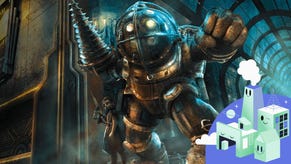BioShock
Harvest soon.
"How can you do this to a child?!"
Um...
How could I? Oh God. But... But wasn't all this caused by her own hand? And how else can I save his family? And myself? "You're the only hope of me seeing my wife again," he says. That's not much of a choice is it? Besides, how can that thing still be called a child?
I've just harvested my first Little Sister. And it's one of the most arresting gaming moments I've experienced in a long time. Earlier this evening, Bioshock creator Ken Levine, facing the same choice, saved her.
"We're going to see what happens when she's turned back into a little girl," he announced. "She's a normal little girl there. In a minute she's going to run off and go back into the vent, and not until later on in the game will you find out what happened to them."
At the end of the first extensive section of Levine's sub-aquatic, dystopian thriller, all players will face that very choice. It's at the very heart of what Bioshock is all about; and your decision, Levine insists, will shape the rest of your experience. "Depending on who you follow, your character grows differently, you play the game differently."

Having seen Ken save the Little Sister, I was always going to go for the harvest option. Just for the sake of editorial balance, you understand. It was hardly a big deal. Until I saw what happens... But we'll get back to this later.
We've been tickled, teased and tantalised by Bioshock for what now seems an age; it rocketed up toward the top of our Eurogamer's Most Wanted list immediately after Kristan emerged slack-jawed from last year's E3 presentation. "Game of the show!" lots of people gushed, despite not having got within harvesting distance of a joypad.
The story should be familiar to anyone who has followed the game's progress since then. Set in the mid-20th century, post-WWII, Rapture is a utopian fantasy made real by Andrew Ryan, a renowned industrialist and capitalist who desires to create the perfect society on Earth, populated by the greatest human minds, to escape the corruption and poison of ordinary humanity. Rapture will be his apotheosis.
Unsurprisingly, it all goes wrong. As Levine notes: "The trouble is philosophies are these ideals and people are not ideal. And what happens when people mix up with these ideals? That's what Rapture is - really interesting ideas screwed up by the fact that we're people."

Rapture's "interesting idea" was advanced genetic modification of humans, fuelled by the discovery of 'Adam', a substance made by a sea slug parasite found close to the sub-aquatic paradise. Tenenbaum, a brilliant scientist and Holocaust survivor, manages to harness these cells to create Plasmids - intravenous genetic hits which grant the user instant super-human abilities. But in the end, like Frankenstein's monster, the creation turns on its master.
Having selected either Easy, Medium or Hard difficulty, the playtest begins at the very beginning, during the much-discussed but never previously seen opening sequence. Your plane has crash-landed in the ocean. Alive, and disoriented, you guide you character swimming through the burning wreckage until you catch site of the looming presence of a lone, dark lighthouse. This, as you'll find, is your one-way ticket to Rapture.
Inside the lighthouse, plaques for Science, Art and Industry indicate the intellectual ideals sought by Ryan. A capsule in the basement of the lighthouse is your vehicle to Rapture. There follows a cinematic, sweeping voyage to the bottom of the ocean, as Rapture's magnificent art deco structure reveals itself. All areas of the city we're seeing, Levine assures us, we'll visit during our adventure.

"All good things of this Earth flow into the city", proclaims the motto above the entrance to the city, with unintentional irony. Still inside the capsule, our first hint of the horrors within presents itself, as a hideous, disfigured man slaughters another right in front of the capsule.
This is a Splicer, a citizen of Rapture turned genetic monster through the sinister side-effects of Adam. It's unsettling stuff, and a fantastically engaging opening sequence that sets the scene for what lies ahead.
You're contacted by a mysterious Irish man named Atlus, who will be your guide through Rapture. His wife and child are still alive somewhere in the city and he needs your help to rescue them, in exchange for helping you to survive. Having just witnessed an hysterical, vicious murder from six feet away, it seems like a fair trade-off.










.png?width=291&height=164&fit=crop&quality=80&format=jpg&auto=webp)




.jpg?width=291&height=164&fit=crop&quality=80&format=jpg&auto=webp)
